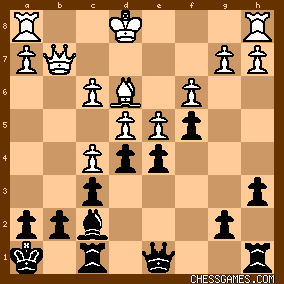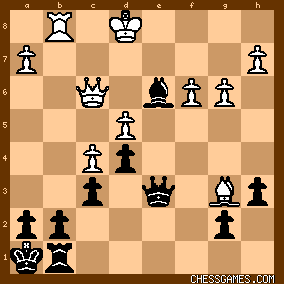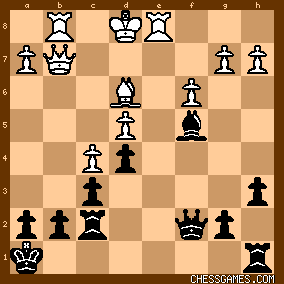| Jan-15-04 | | Whitehat1963: Rubinstein gives Alekhine a lesson, pure and simple. |
|
| Jan-15-04 | | fred lennox: One lesson pure and simple is if there is only one file open, controlling it can be decisive if it leads to controling a weak square to invade with. This is often found in Rubenstein's games. |
|
| Jul-28-05 | | Jgamazo: 25.Kf2? 25.a4!? the bishop has nowhere to go. Then b3 , Kf2, and Rd1 to control the d file. if 25. ... Rxd1+ 26.Qxd1 Rd7 27.Qc2 Qd8 28.b3 Rd1+ 29.Kf2 Rxg1 30.Kxg1 Bd3 31.Qd2! pins the bishop. |
|
| Jul-28-05 | | Kangaroo: <Jgamazo> made an attempt to improve Alekhine. <<Jgamazo>: 25.Kf2? 25.a4!? the bishop has nowhere to go. Then b3 , Kf2, and Rd1 to control the d file. if 25. ... Rxd1+ 26.Qxd1 Rd7 27.Qc2 Qd8 28.b3 Rd1+ 29.Kf2 Rxg1 30.Kxg1 Bd3 31.Qd2! pins the bishop.> Very long analysis can hardly be 100% correct. In particular, after
<25. a4!??> Black can simply respond <25... Rfd7>. This remark is aimed at pointing to one possible move, not necessarily the best one. Perhaps, there are better alternatives for Black after 24 moves. The position looks much better for Rubinstein. However, since <25... Rfd7!> not only increases the pressure on d-file, but also clearly opens the way back (heading to <f7>, for instance) for black bishop on c4, all expressions in the comment emotionally made by <Jgamazo> will lose their sense (if they had any). In particular, the bishop is neither trapped nor pinned anymore. |
|
| May-19-07 | | Bridgeburner: PART I
Rubinstein outfoxed Alekhine in this, their first meeting. Notwithstanding its errors, this game has the richness and complexity one would expect of a meeting between these two combative masters, even if Alekhine was only 17 at the time. <1.e4 e4 2.Nf3 Nc6 3.Bc5 a6 4.Bxc6 dxc6 5.d3> Alekhine played and won with <5.d3> in Alekhine vs Favorsky, 1909 , and in Alekhine vs G Helbach, 1909. Possibly encouraged by these successes, Alekhine plays it against Rubinstein, but this time with a quite different result. He did not appear to have played this variation again. Parenthetically, of the 8 games recorded in Opening Explorer in which Black responded to <5.d3> with <5…f6> as in this game, Black won 5 and draw 3. The advent of <5.d4> and <5.0-0> has made this line obsolete. <5…f6 6.Be3 Bg4>.
Does anyone know why this move was inevitably played in this position? The pin allowed by the absence of White’s LSB has no real meaning in limiting White’s movements, unless one sets a trap for oneself resembling the one amusingly constructed by Cornelius Trimborn in: C Trimborn vs Loman, 1903: <7.Nbd2 Bd6 8.0-0 Ne7 9.c3 Qc8 10.Qc2 0-0 11.Ne1? Be2>. Unless Black intends to castle Queen side (in which case <6…Be6> is probably better), <6…Ne7> may be worth trying before committing the LSB. Having said this, Max Euwe won a beautiful game with Black in Wiersma vs Euwe, 1927 after playing <6…Bg4>. There followed <7.Nbd2 Qd7 8.h3 Bh5> and thinking Euwe had fallen into a dastardly trap, Wiersma played 9.Nxe5?! Bxd1 10.Nxd7 Bxc2 11.Nxf8 Kxf8> and was completely outplayed in a classic endgame. |
|
| May-19-07 | | Bridgeburner: PART II
<7.Nbd2 c5>
This is the only game with <7…c5> and may have been another opening innovation by the opening innovation master. That he wins this game either convinced neither himself nor anyone else in the big league of its virtues, or remains unexplored simply because the whole variation has been superseded. Of the five games in the Opening Explorer database that run the variation until <7.Nbd2>, three play <7…Qd7> (drawn twice, Black won once), one plays <7…Bd6> (won by Black – see the Trimborn game cited earlier) and this game (again won by Black). While <7...c5> violates the conventional theory of development at the time and represents the fifth move by pawns in the first seven moves of the game, it seems to displays some admirable virtues: it creates a space for the King Knight at c6, some more space in the centre including pressure on d4 which can be relieved at the cost of undoubling Black’s pawns – surely a bonus in this variation. <8.Nc4 Bd6 9.Qd2 Ne7 10.Qc3 Nc6 11.Nxd6 cxd6> White has exchanged a Knight that’s moved three times for a Bishop that’s moved once, undoubling Black’s pawns in the process. <12.Nd2 Be6 13.f4 0-0 14.Nf3> Now he’s moved the other Knight three times. Black’s advantage accumulates. <14…Nd4 15.Qd2 d5 16.c3> White’s sixteenth is not the best as it adds righteousness to Black <16…dxe4>, which Black was likely to play anyway. It creates a weakness at d3 that Black is later able to exploit to great advantage. <16.0-0> was indicated (16…dxe4 17.dxe4 Qb6 18.b3). Position after <16.c3>: 
click for larger view<16…Nxf3>
Better than either of the pawn exchanges. An interesting speculative piece sacrifice in this position would be <16...Re8!?> <17.gxf3 c4?!>
Black’s seventeenth move is the fateful move that opens the d-file that Rubinstein will ultimately turn to his advantage. However, <17…d4> creating a powerful pawn wedged in White’s position, opening the c-file and pressuring the queen side was probably better as the move played allows White to equalise, and even to take a trouble free initiative. The position after <17.gxf3>: 
click for larger viewFor example: <17...d4 18.Bf2 exf4 19.cxd4 cxd4 20.Qxf4> and Black has a strong initiative, eg: <20…Qb6 21.b3 (or <20.Qd2 f5!> with initiatives on both wings) 21.Qa5+ 22.Ke2 Rac8> or <20...Rc8 21.0-0 Rc2 22.b3 Qa5 23.Rfc1 Rxc1+ 24.Qxc1 Rc8> |
|
| May-19-07 | | Bridgeburner: PART III
<18.f5 Bf7 19.Rg1>
This would make more sense if White intends to exchange Queens and simplify to a drawish ending. <19.Qg2 Kh8 20.d4> solves all White’s problems: 
click for larger viewFor example if <20...dxe4> then <21.fxe4 exd4 22.Bxd4 Qa5 23.0-0 Rae8 24.Rf4 Re7 25.Rh4 Qc7 26.Kh1 Bg8 27.Rg1 a5 28.Qg4> constitutes a strong buildup against Black’s King. Better is probably <20...exd4 21.Bxd4 Be8 22.0-0-0 Rf7 23.Rde1 dxe4 24.fxe4 Qa5 25.Kb1 Bc6> although White still has a strong initiative. In both variations, the positioning of the White DSB on d4 with the threat of e5 provides excellent pressure for White. <Kh8 20.dxc4>
<20.d4> is still a better move, freeing White’s game. The threat of dxe5 allows the DSB onto a powerful, central position, with the ongoing threat of e5. The text dissipates White’s advantage to a very drawish position. <20…dxe4 21.fxe4>
White should exchange Queens on this or the next move, to be consistent with his 21st move (to force the King to lose a couple of tempo in the endgame). Correct is <21.Qxd8 Rxfd8 22.fxe4> with equality and a drawish endgame. <21…Bxc4>
The defensive resource Rubinstein draws on to counter Alekhine’s next move serves to hasten his challenge on the d-file which, as <fred lennox> pointed out, provides Rubinstein with the opportunity on giving a lesson on how to put such an asset to good use. Unaware that he’d already blown his advantage, the teenage Alekhine may have fancied his chances and the more experienced Rubinstein was probably happy to play along with this notion. <22.Qg2 Rf7>
<22…Rg8 23.b3 Bb5 24.c4 Bc6 25.Qc2 (switching the point of defence of the vulnerable e pawn) 25…Qd7 26.Rg4 g6 27.Rd1 Qf7> is also good, but not <22…Qe7?? 23.Bc5!> <23.Rd1>
White needed to put the question to Black’s dominant Queen Bishop with 23.b3. However, it is possible that Alekhine, angling for that win, avoided this variation foreseeing the possibility of a forced perpetual check by Black after <23.b3 Qd3?! 24.Qd2 Qxe4 25.bxc4 Rd7>. |
|
| May-19-07 | | Bridgeburner: PART IV
<23…Qc7>
Also good is <23….Rd7>. For example, if <24.Rxd7 Qxd7>: A. <25.b3 Bd3 26.Qd2> (<26.Bb6?> loses! <26…Rg8! (freeing the Queen and threatening g6 in some variations) 27.Qf3 Qd6!> and Black is embarrassed for a viable continuation, eg: 
click for larger view<28.Ba5 Qc5 29.Rg3 Qxa5 30.Qxd3 Qxa2> or <28.Bf2 Rc8 29.Qg4 Qc7 30.Bc5 b6 31.Rg3 Rd8 32.Bd4 exd4 33.Rxd3 dxc3 34.Rxd8+ Qxd8>. Even a desperation move like <28.Bc7> flops dismally: < Qc5 29.Rg2 Bxe4 30.Qxe4 Qxc3+ followed by Qxc7>). The pawn at e4 is a fatal weakness.) <26…Qd6 27.c4 Rd8 28.Rg4 Qc7 29.Qc3 Qc6 30.Qa5 Rd6> or B. < 25.Qd2 Qxd2+ 26.Kxd2 Rd8+ 27.Kc1 Bxa2 28.Bb6 Rd7 29.Kc2 Bc4 30.Rg3 Be2 31.b3 Bd1+ 32.Kb2 Kg8 33.c4 Kf7 34.Rh3 h5> or C. <25.Qc2 Rd8 26.Bb6 Rc8 27.Be3 b5 28.Qd2 Qe7 29.a3 Qb7 30.Rg4 Qc7 31.Kf2> Rubinstein’s choice of <23…Qc7> ahead of <23…Rd7> as his 23rd move is objectively speaking a line ball decision. However, the former left Alekhine with less obvious responses from which to choose, and therefore more scope for error. Although it’s impossible to know whether this was a psychologically canny move by the more experienced Rubinstein, Alekhine immediately falls between two stools and stumbles into a wrong plan (choose your cliché). 
click for larger viewThe only move to preserve equality is <24.b3> followed by <25.c4> evicting Black’s QB from its dominant position, mobilising his queen side pawn majority, and preparing to seize control of the d file. <Then> he should play <26.Qc2>, as now the evil Bishop has been evicted from the heart of White’s position. <24.Qd2> seizing control of the d file immediately at the cost of the a pawn is also good, eg: <24…Bxa2 25.Qd6> |
|
| May-19-07 | | Bridgeburner: PART V
<24.Qc2?>
As mentioned earlier, <24.b3 Bb5 25.c4 Bc6 and then 26.Qc2> was much better. Both <26…Rd8 27.Ke2 Rfd7 28.Rxd7 Rxd7 29.a4> and <29.Rd1 Rxd1 30.Kxd1 Qd7+ 31.Ke1 Kg8 32.c5 Bb5 33.Kf2> are quite defensible. Another good alternative is <24.Qd2 Bxa2 25.Qd6>, viz: A. <25...Qc8 26.h4 Bb3 27.Rd2 Ba4 28.h5 Rd7 (<28…Bc6 29.h6 gxh6 30.Qd3 Rd7 31.Qc4) 29.Qe6 Rxd2 30.Qxc8+ Rxc8 31.Kxd2 Bc6>)> and White probably has sufficient compensation for the pawn, given the opposite colored Bishops. B. <25…Bb3 26.Rd2 Ba4 27.Bb6 Qc6 28.Qxc6 Bxc6 29.Rg4 g5 30.fxg6 hxg6 31.c4 Rc8> C. <25...Qc8 26.Kf2 Bb3 27.Rd2 Ba4 28.Qe6 Qxe6 29.fxe6 Re7 30.Rd6 Bc6 31.Rgd1> The simple <24.a3?>, is inferior to <24.b3> as it does nothing to neutralise White’s LSB: <24.a3 Rd8 25.Kf2 Rxd1 26.Rxd1 Rd7 27.Re1 Qd8 28.Qg1 Bb5> <24…Rd8 25.Kf2?>
<25.Rxd8+> (eg: <25...Qxd8 26.Rg4 Rd7 27.b3 Bd3 28.Qc1 b5 29.Kf2 Qa8 30.Qd1 Qc8 31.Qe1>) or <25.Rg2> (intending to cover the d file) were preferable. Although Black now has the advantage, White’s game may still be defensible. Rubinstein now seizes the d file. <25…Rfd7 26.Qa4?>
This move, attempting to protect both the e-pawn and the a-pawn, is a loser. <26.Rxd7> was beyond essential, however <26…Qxd7 27.Rg4 Bxa2> (<28.b3 Qd1>) should still win, although there is still plenty of work for White. <26…Bd3?!>
An inaccuracy by Rubinstein that nearly lets a hard earned win slip through his fingers. <26…b5!> is the knockout blow: <27.Rxd7 Qxd7 28.Qc2 Bd3 29.Qd1 Bxe4 30.Qxd7 Rxd7 etc> |
|
| May-19-07 | | Bridgeburner: PART VI
<27.Qb4??>
Loses the plot altogether. The Queen cannot continue to protect the e-pawn. The Rook can do it better: <27.Rg4!> and it’s far from clear how White wins: 
click for larger viewIf:
A. < 27...a5> then <28.Rd2 b5 29.Qd1 Bc4 30.Rxd7 Rxd7 31.Qc2> seems to hold. B. <27…b5 28.Qxa6 Bxe4 29.Bb6 Qc6 (or <29…Rd2+ 30.Rxd2 Rxd2+ 31.Ke1 Qd7 32.Bd4!>) 30.Rxd7 Qxd7 31.Rxe4!> holds easily C. <27...Rd6 28.Qb4 a5 29.Qc5!> should hold but not <29.Qb3? Bc4> or <29.Qa4? Bc2!> <27…b5 28.Rg4 (too late!) Be2! 29.Rxd7> (naturally if <29.Kxe2 Rxd1>) <29…Qxd7 30.Rg1 (<30.Kxe2 Qd1+>) Bh5 31.Re1 Qd3 32.Qe7 h6> Unnecessary. <32…Rg8!> relieves the White Queen from back rank guard duty so it can lunch on White’s e and f pawns. If White uncovers the defence of the e4 pawn with <33.B to c5, b6 or a7>, then <33…Qd2+> starts the mopping up operation. And if <33.Bc1> then <34.Qh3> followed by <34.Bf3> soon finishes the job. <33.Kg1 Kh7?!>
Also unnecessary, and could have made the win much more difficult. <33…Rg8> was the right move. <34.Bf2??>
Suicide. Alekhine jumps and lands into a mating net, rather than a safety net. <34.Bc1> was necessary as it would have led to an endgame that would have needed some effort for Black to win: 
click for larger viewFor example:
A. <34...Rg8 35.Qa7 Qh3 36.Qf2 g6 37.Re3 gxf5+ 38.Kh1 Qg4 39.Qxf5+ Qxf5 40.exf5 Rd8 41.Re1 Bg4 42.Kg2 Bxf5> B. <34...Kh8 35.Qc5 Bf3 36.Qe3 Bxe4 37.Qxe4 Qxe4 38.Rxe4 Rd1+ 39.Kg2 Rxc1 40.Re2 Rd1 41.h4 Kh7> C. <34...Be2 35.Qf7 Qxe4 36.Qg6+ Kh8 37.Bxh6 Qg4+ 38.Qxg4 Bxg4 39.Be3 Bxf5 40.Ra1 Kh7 41.a4 Kg6 42.axb5 axb5 43.Ra5> D. <34...Rd7 35.Qe6 g6 36.fxg6+ Bxg6 37.Qg4 h5 38.Qg3 Bxe4 39.Qxd3 Rxd3 40.Kf2 Rf3+ 41.Kg1 Bd5 42.a3 Kg6> E. <34...b4 35.Qc7 (if <35.cxb4? Rd4 wins> or <35.Qxb4? Qh3> wins) Rd7 36.Qc6 g6 37.cxb4 gxf5 38.Qc3 fxe4 39.Qxd3 exd3 40.Bd2 Bf3 41.Kf2 e4 42.Ke3> These are probably all winnable, but would take considerable effort to extract the full point. <34…Qh3 35.Bd4 Bf3 36.Kf2 Qg2+ 37.Ke3 Bxe4 38.Re2 exd4+ 39.cxd4 Qf3+
0-1>
Mate in five follows with: <40.Kd2 Rxd4+ 41.Ke1 Qh1+ 42.Kf2 Qg2+ 43.Ke3 Rd3+ 44.Kf4 Qf3# > |
|
Feb-05-11
 | | Penguincw: Rubinstein's other victory against Alekhine with the black pieces :Alekhine vs Rubinstein, 1912 |
|
| Dec-16-13 | | The17thPawn: Its clear this was an exhibition but were the time controls normal for the period? |
|
| Dec-14-14 | | TheFocus: Exhibition game played in Moscow, Russia on January 2, 1910. |
|
Jul-16-17
 | | MissScarlett: I think this shoulc be counted as classical. |
|
| Dec-25-18 | | DonChalce: hm... i should take note and be more cautious. letting a file open like that and making such a blunder... it's not the best move. |
|
|
|
|





